Petroleum coal mine
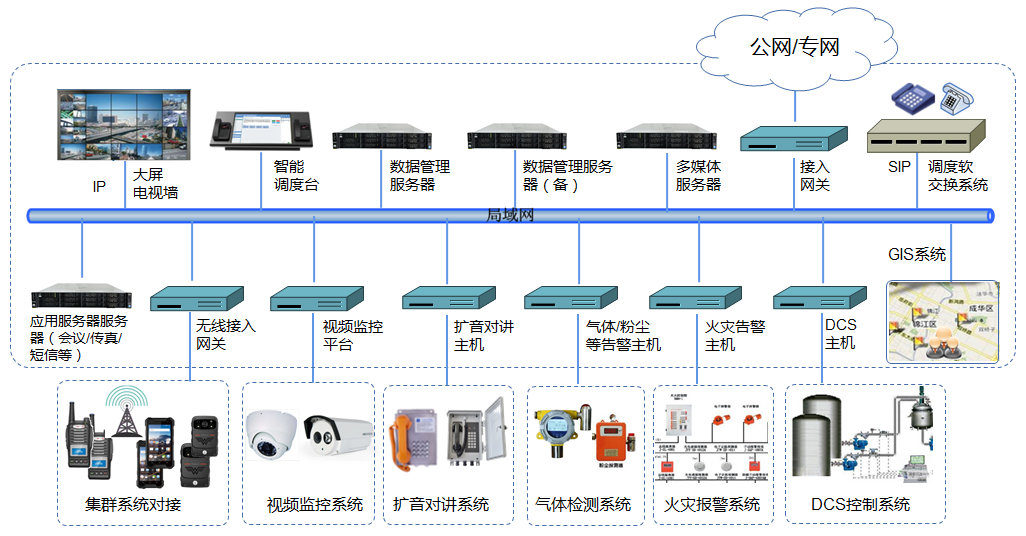
The fire command and dispatch system platform is aimed at solving the drawbacks of current communication, such as multiple platforms, scattered deployment, inability to exchange information, and "information islands", while taking into account the development needs in the next five years. The fire command and dispatch system platform integrates functional modules including dispatch calls, video surveillance, video conferences, personnel positioning, wireless communication, emergency plans, and emergency command. These functional modules can be deployed step by step, and all modules are incorporated into the entire fire command and dispatch system to realize the digitization and integration of operations and emergency communications.
The application revolves around "application integration, management visualization, business collaboration, and process flexibility". It ensures that the platform and system have a high level of security, advancement, economic practicality, scalability, and openness. Mature technologies and tool platforms are adopted, and at the same time, it has a certain degree of backward compatibility to protect the long-term investment of the user unit in existing software and hardware resources.
It seamlessly connects various communication methods such as voice, short messages, faxes, wireless clusters, videos, and networks, and adopts standardized and normalized fully open interfaces to realize the integration of internal, external, new, old, equipment, and system communication interfaces.
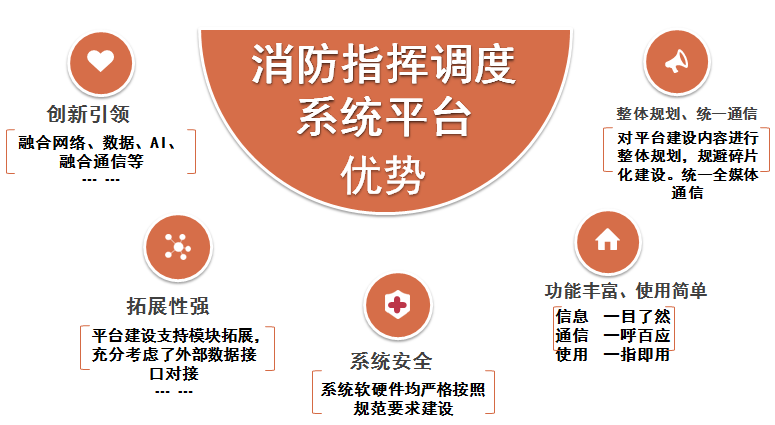
Integration of communication technologies
Integration of communication operators
Integration of communication methods
Integration of system interfaces
Integration of operation terminals
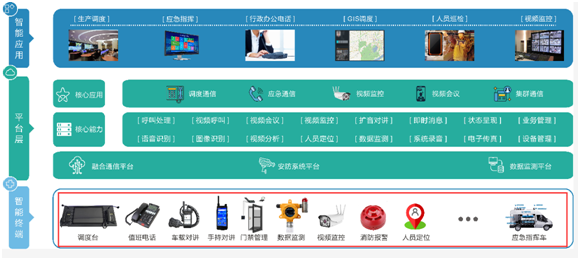

Function Introduction
Dispatch communication
The telephone system adopts the "IP&TDM+IOT" design concept, which can support VoIP broadband protocols and narrowband signaling, and is suitable for any NGN/VoIP voice networking. Moreover, it also supports industry-level optical network data exchange functions, compatible with various interfaces such as FE/GE, E1, and serial ports. It not only meets the IP&TDM voice communication, but also supports MSAP/MSTP/PTN and other interfaces, meeting the characteristic needs of customers in industry applications.
The dispatch system has powerful functions and can be completed with one click; the dispatch interface is user-friendly and the operation is simple. Through the dispatch software, flexible and convenient dispatch function operations can be realized, such as transfer, forced insertion, forced disconnection, telephone conference, emergency call, one-key alarm, one-key callback and other functions. The system can support multiple dispatch methods such as voice, intercom, video, pictures and text to meet the needs of users in different application scenarios.
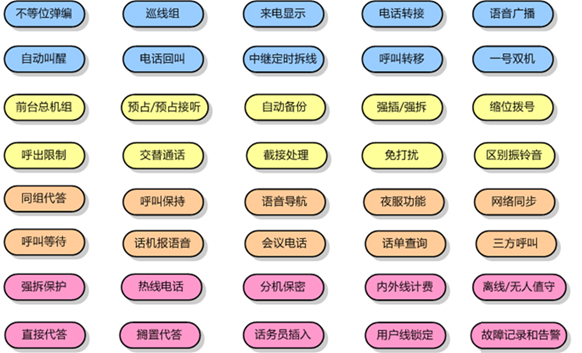
The converged dispatch communication system can be used with video surveillance systems of various mainstream manufacturers with different standards. The video surveillance system is integrated into the converged dispatch communication to realize unified management and dispatch.
It supports monitoring grouping and custom editing. Each camera can be configured with relevant position information and flexibly grouped. The monitoring cameras to be viewed can be quickly found through fuzzy query by group or location name.
It can push real-time monitoring images, and GPS positioning video surveillance can track the real-time pictures of moving objects.
Alarm terminals are linked with video surveillance for on-wall display. Voice devices can realize video linkage when off-hook or on-hook, and video linkage on-wall can be carried out when dialing emergency broadcast terminals or emergency hotlines.
Through the monitoring screen, one-click review and capture of relevant monitoring records can be realized. Monitoring records can be shared from the dispatch command room to other sub-control centers with one click.
Personalized editing of monitoring: It supports configuration of different monitoring screen combinations such as 1-screen, 4-screen, 9-screen, 16-screen and 24-screen. Personalized editing of screen combinations such as 1 large + 5 small, 1 large + 7 small, 1 large + 12 small can be carried out according to needs.
Through information-based plan management, it can meet users' needs of compiling plans online, realizing electronic plans and online preview; at the same time, it supports structuring and instructing plans. Centering on the whole process of accident response and emergency command, text plans are structured into executable instructions for on-site command; combined with the application of electronic maps, plan instructions are combined with icons, and emergency command deployment is carried out on the map to form an emergency command map for simulation decision-making in command and dispatch.
Through plan entry and plan structuring, it can provide enterprise users with entry of basic information such as plan version information, effective time and signatory, support plan association with accidents, emergency personnel, materials, equipment, surrounding dangerous chemicals and other information, and allow uploading electronic plan files for online preview and viewing.
Through the plan linkage and plan instruction issuance page, the system can analyze the accident type and accident map according to the alarm at the accident site, and link the corresponding plan and plan instructions according to the accident location and area. Each instruction can be configured with vivid icons and pictures, and positioned and marked on the map to form an emergency command deployment map; at the same time, commanders can select post personnel, specify the instruction execution time and execution duration, issue the instruction to the command terminal, and on-site commanders carry out emergency rescue according to the instruction information.
Establish eight major databases including plan database, knowledge database, case database, expert database, hazard source database, key protection target database, emergency rescue force database and emergency resource database. Paper documents are uniformly collected and imported into electronic documents, and the required knowledge database can be quickly located through keyword fuzzy query, supporting one-click sharing and one-click printing, so as to improve the support response efficiency of technical experience and knowledge in emergency response.
Deploy dispatch platforms at all levels, and realize custom dialing and dispatch authority control between fire emergency centers, emergency terminals, internal lines and external lines through flexible authority allocation and formulation.
Strengthen dispatch communication means, integrate communication systems such as DMR intercom, broadband intercom and broadcast intercom, so that the dispatch center can realize voice, such as audio and video, text, data and information notification. It supports value-added functions such as voice and video grouping, full dispatch, and real-time personnel trajectory positioning.
Create a "three-dimensional" perceptible platform. By connecting with video surveillance, DCS monitoring system, fire protection system and existing data platforms, the previously "separate" and scattered data are summarized to the platform center, and combined with map information to present multi-dimensional and three-dimensional emergency perception, providing data support for dispatch.
The broadcast can support three playing mechanisms. 1. Timed cycle playback: it can cycle play by setting the date, time and custom playing audio. 2. Temporary broadcast: the dispatch center can select the terminal to be broadcast and click broadcast for temporary notification. 3. TTS broadcast: text can be entered into the dispatch system, and timed broadcast can be carried out by setting the broadcast time and broadcast terminal.
Each broadcast will generate a broadcast record, which includes the broadcast date, time, initiating broadcast terminal, executed broadcast terminal, terminals with successful broadcast, terminals with failed broadcast, and broadcast content.
Automatic broadcast in any partition: through the setting of the control software, any one or multiple terminals can be freely divided into regions and combined arbitrarily. At the same time, each region can automatically play different contents without interfering with each other.
The emergency alarm system plays music at ordinary times. When there is an emergency broadcast request, the system immediately forces to switch to the emergency broadcast state and conducts emergency broadcast to the required broadcast area; at the same time, the system has an alarm linkage function. When there is an alarm, it will automatically notify each control node of the local police situation, and automatically alarm the affiliated area and affected area according to the scope and harm of the police situation, so as to improve the efficiency of crowd evacuation and reduce the loss degree.
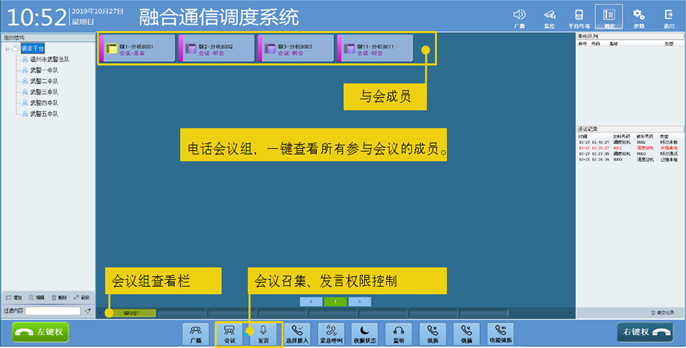
Dual-mode of Wide and Narrow Bands: Intercoms can be connected to the converged dispatch communication system through broadband intercom (WIFI, 4G) and narrowband intercom (frequency band).
Permission Control: The command center can group, control and monitor handheld intercom groups of different groups, and at the same time send instant messaging contents including text, audio, video, pictures, expressions, files, etc.
Intercom Permission: In the broadband intercom mode, the intercom permission of intercom personnel can be set. Those with higher permissions can interrupt the calls of intercom personnel with lower permissions.
Emergency Guarantee: When WIFI and 4G signals are unavailable, handheld intercoms can be switched to frequency band intercom to ensure that voices can still be heard in emergency situations.
The dispatch command center platform can directly intercom with handheld terminals by 圈选 on the GIS map or selecting groups, and the dispatch command center platform can check the online status information of handheld terminals.
The dispatch command center platform can directly intercom with handheld terminals by 圈选 on the GIS map or selecting groups.
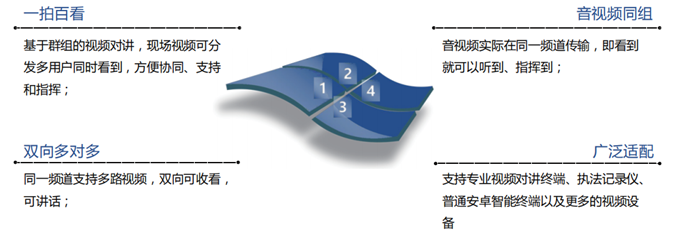
Supports different recording modes such as voltage-controlled, voice-controlled, code-controlled, and continuous recording.
Allows real-time monitoring of calls and checking of line status.
Enables querying of recording results according to various conditions, such as call time, channel, call duration, and missed calls.
Automatically records the time, incoming/outgoing status, and duration of each call, with online playback and download backup of recordings.
Supports configuration of different recording modes and parameters for each channel.
Allows scheduling of recording time and planning of recording according to specific time periods.
Supports setting of non-recording lists, enabling selective recording based on numbers.
When the storage space reaches the preset limit, it can generate an alarm and automatically delete old recording files for cyclic recording.
Supports local and remote backup of recording files, and recording files can be uploaded to the storage server via FTP across the network.
The recording system supports operation log recording, and important operations can be queried and traced back.
Multi-level permission management, opening different permissions for different accounts, and corresponding permissions can check and listen to recording records within the permission scope.
Alarm terminals are linked with video surveillance for on-wall display; video linkage can be performed when voice devices are off-hook or on-hook, and video linkage on-wall can be carried out when dialing emergency broadcast terminals or emergency hotlines.
Supports real-time push of monitoring images, and GPS positioning video surveillance to track real-time pictures of moving objects.
Real-time monitoring of the harmfulness of gases in confined environments, the safety of personnel, temperature, and the suddenness of fires.
Networking mode: It can be used with video surveillance systems of various mainstream manufacturers with different standards. The video surveillance system is integrated into the converged dispatch communication to achieve linkage, unified management and dispatch.
System features: Supports monitoring grouping and custom editing. Each camera can be configured with relevant position information and flexibly grouped. The monitoring cameras to be viewed can be quickly found through fuzzy query by group or location name.
Personalized editing of monitoring: Supports configuration of different monitoring screen combinations such as 1-screen, 4-screen, 9-screen, 16-screen and 24-screen. Personalized editing of screen combinations such as 1 large + 5 small, 1 large + 7 small, 1 large + 12 small can be carried out according to needs.
Through the monitoring screen, one-click review and capture of relevant monitoring records can be realized. Monitoring records can be shared from the dispatch command room to other sub-control centers with one click.
Cameras with pan-tilt control functions can also be controlled via pan-tilt. It can control video focusing, aperture adjustment, rotation, preset point setting, etc.
- Prev: Electric power industry
- Next: Chemical industry




